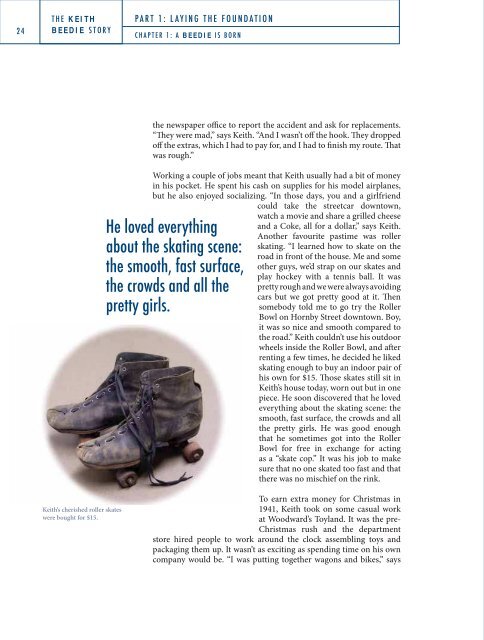Download The Keith Beedie Story - Beedie Group
Download The Keith Beedie Story - Beedie Group
Download The Keith Beedie Story - Beedie Group
You also want an ePaper? Increase the reach of your titles
YUMPU automatically turns print PDFs into web optimized ePapers that Google loves.
48<br />
THE KEITH<br />
BEEDIE STORY<br />
He didnʼt know<br />
what type of job<br />
he wanted, but<br />
he thought<br />
tinkering with<br />
engines would<br />
be fun.<br />
PART 1: LAYING THE FOUNDATION<br />
CHAPTER 4: SETTING UP SHOP<br />
MAKING DO<br />
When <strong>Keith</strong> returned to Vancouver his future was wide open. “I wasn’t sure<br />
what I wanted to do,” says <strong>Keith</strong>. One of the benefi ts offered to servicemen<br />
was the Canadian version of the American G.I. Bill, which provided<br />
educational opportunities to help men re-establish themselves after the<br />
war. <strong>Keith</strong> took advantage of the chance to get some training, enrolling in an<br />
automotive mechanics course at Vancouver Technical High School. “I knew I<br />
liked taking things apart,” says <strong>Keith</strong>. “I fi gured I may as well do something<br />
useful and learn how to put them back together, too.” He didn’t know what<br />
type of job he wanted, but he thought tinkering with engines would be fun.<br />
Spending his days in the school shop surrounded by cars, the old<br />
Durkopp bike that had served <strong>Keith</strong> so well as a teenager no longer<br />
seemed like a fi tting mode of transportation for an ambitious young<br />
man. He wanted a car of his own. Th ere was one hitch. He had<br />
considerable driving experience from cruising around in his dad’s car,<br />
but he had never taken the test to get a driver’s licence. He approached<br />
a friend of his, Ted Th orpe, who had an Auburn convertible, and<br />
asked to borrow it for the test. “It wasn’t even a real<br />
convertible,” <strong>Keith</strong> says. “It didn’t have a top at all.”<br />
His friend loaned him the car and <strong>Keith</strong> headed to<br />
the Department of Motor Vehicles, downtown on<br />
Georgia Street. He arrived at the offi ce at 4:30 p.m.<br />
“Th e place closed at fi ve,” <strong>Keith</strong> remembers. “Th e<br />
guy behind the desk didn’t seem too happy to see me.<br />
Must have been anxious to get home, or something.”<br />
Th e examiner gave <strong>Keith</strong> the test, which he started<br />
fi lling out. Aft er watching <strong>Keith</strong> read over a couple<br />
of questions carefully before making his choice, the<br />
examiner lost patience and grabbed the sheet out of<br />
<strong>Keith</strong>’s hands. “He put the piece of celluloid with holes<br />
in it that they use for marking on top of my test and<br />
just ticked all the answers. He got to the end and said, ‘I<br />
guess I should mark one or two wrong to make it look<br />
good.’ ” <strong>Keith</strong> looked on, shocked. With the written test<br />
out of the way, the two went outside to complete the<br />
driving portion of the exam. While <strong>Keith</strong> was inside, it<br />
had started to rain. Th e examiner took one look at the<br />
Auburn with no top, turned around and headed back<br />
inside. “You think I’m going out in the rain in that?”<br />
he asked <strong>Keith</strong>. Th ey returned to the offi ce where the<br />
examiner fi lled out <strong>Keith</strong>’s licence and handed it over.<br />
“And that was it,” says <strong>Keith</strong> with a laugh.<br />
Now he had a licence but no car. <strong>Keith</strong>’s friend Fred Banbury<br />
introduced him to a woman he knew who was trying to sell her 1925<br />
Willys Overland. She’d had it up on blocks through the war and now<br />
she wanted it gone. “I didn’t have any money,” says <strong>Keith</strong>, “so I off ered<br />
her a trade. My portable gramophone for her car. I’d purchased the<br />
gramophone in 1941 for around 15 bucks. She took the deal, so I had<br />
myself a car.” Th e Willys Overland wasn’t a typical automobile. It had<br />
no fuel pump – it used gravity to propel gas into the engine – and<br />
the oil moved via a “splash feed” system. Most unusual of all, the car<br />
had an oil clutch. “A normal clutch can’t get a spot of oil on it or it<br />
malfunctions. Th is one ran in oil. But you couldn’t shift gears unless<br />
you were running at exactly the right speed,” remembers <strong>Keith</strong>. Th e<br />
clutch proved diffi cult to use, so <strong>Keith</strong> sought help from his mechanics<br />
instructor, hoping an expert might be able to shed some light on the<br />
inner workings of the temperamental car. Th e instructor told <strong>Keith</strong> to<br />
bring the car to class and they would investigate. A week or two later<br />
the instructor had tried everything but the clutch was still a problem.<br />
“He gave up,” says <strong>Keith</strong>. “I just fi gured out how to use it as it was by<br />
shift ing at the right speed. No wonder the gramophone had been an<br />
appealing trade for the previous owner.”<br />
A Vancouver Sun article<br />
(2002) looks at <strong>Keith</strong>’s<br />
love of cars. He’s owned<br />
a lot, but has a soft spot<br />
for his fi rst, a 1925 Willys<br />
Overland that he bought<br />
in 1945.<br />
I dropped the oil pan and saw that the con rod bearings were practically worn<br />
out, so my buddies and I cut the tongues off our shoes, wrapped them around<br />
the bearings and were able to get ourselves home that way.<br />
49


